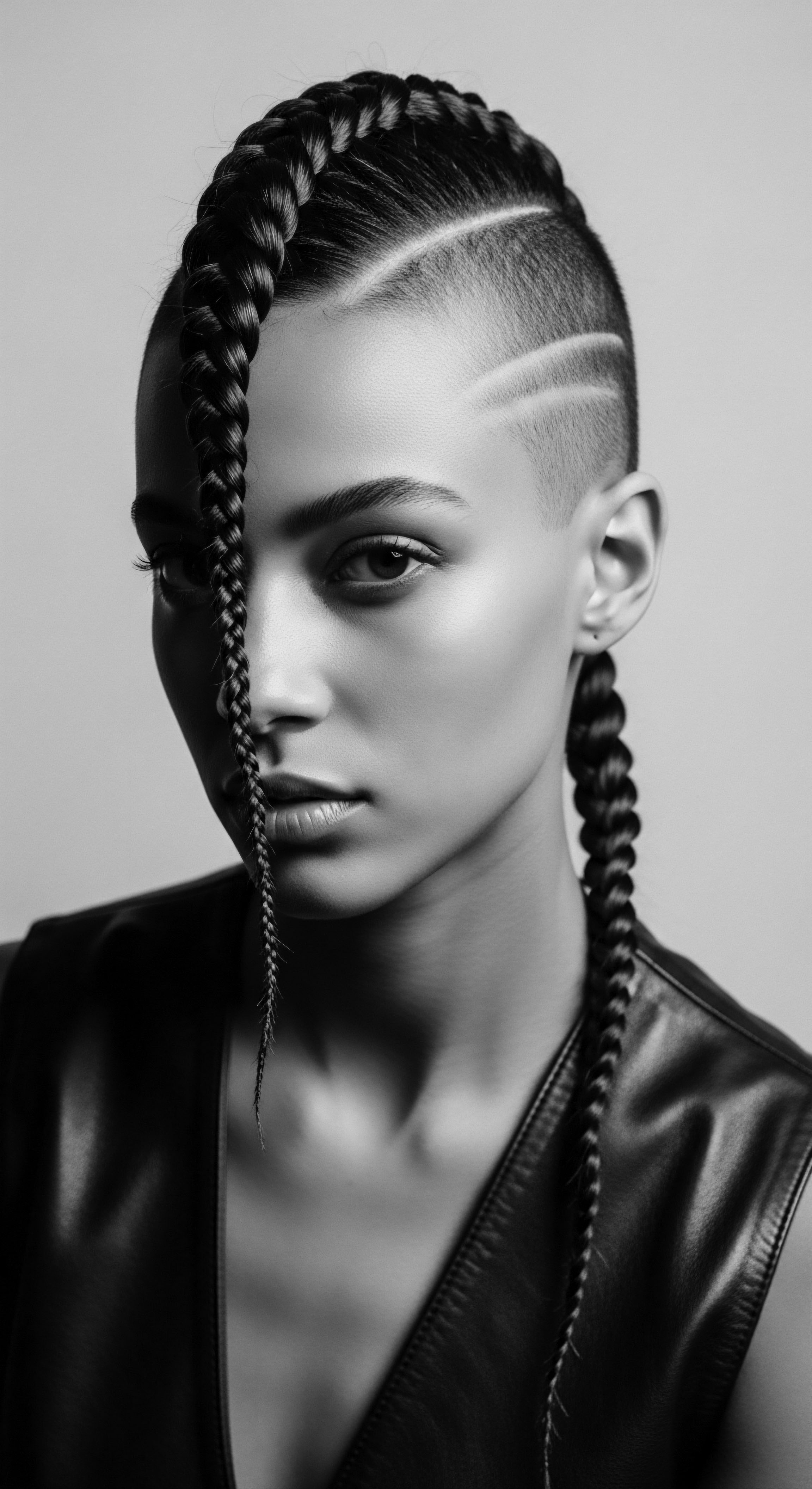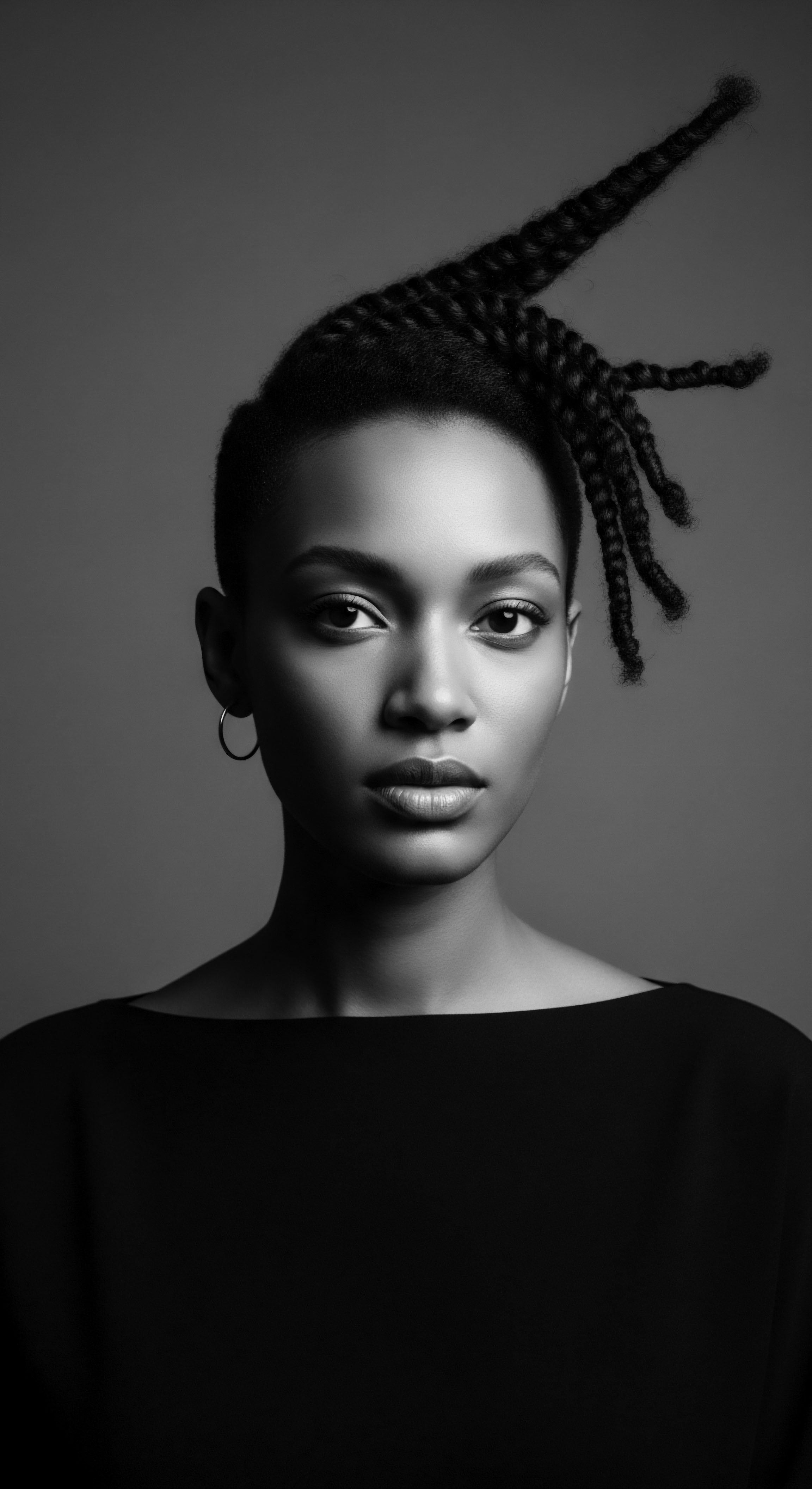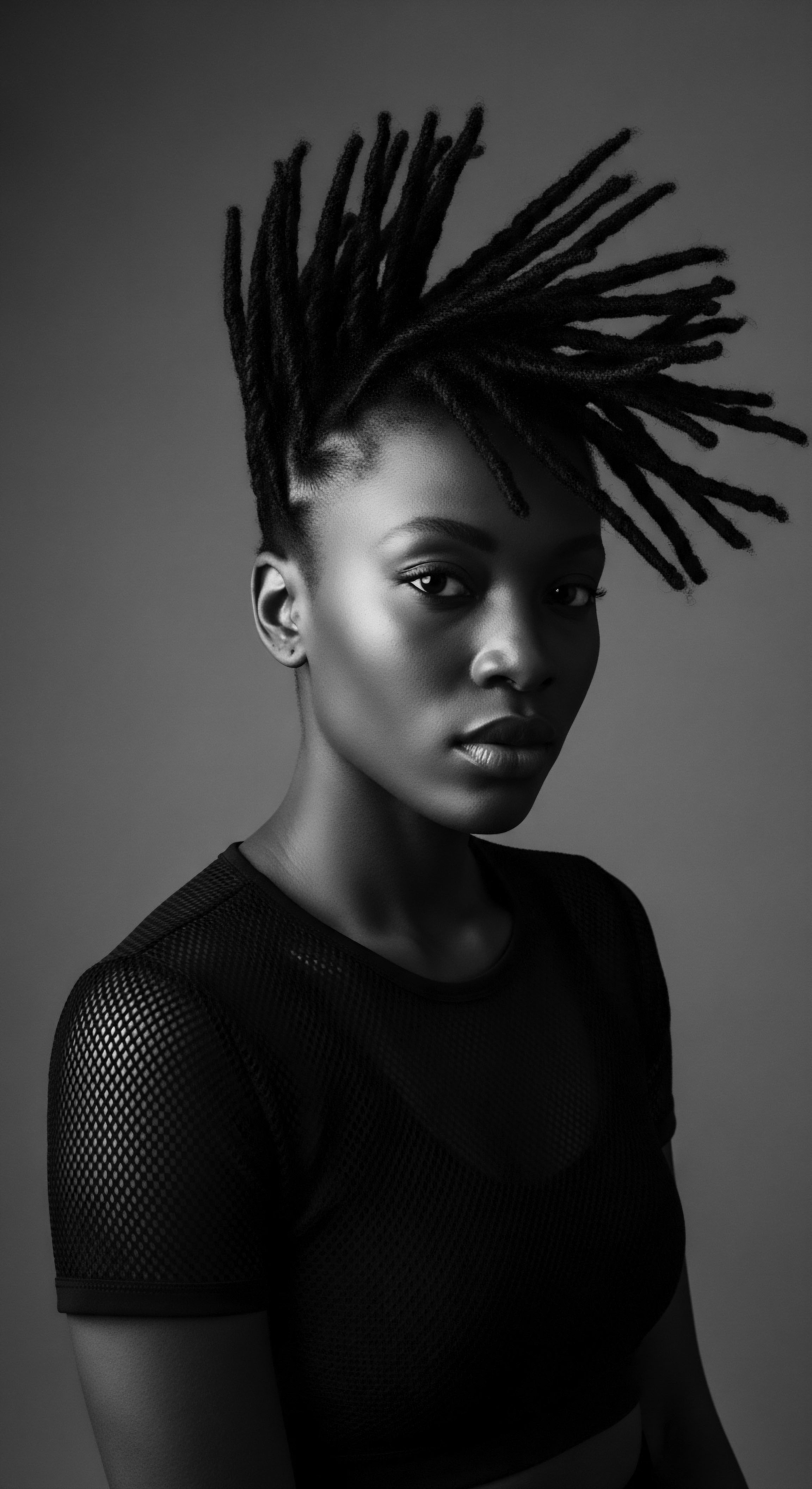
Fundamentals
The concept of Historical Hair Rituals refers to the long-standing, culturally significant practices surrounding hair care, styling, and adornment that have been passed down through generations within various communities. These are not merely acts of personal grooming; they represent deeply embedded systems of knowledge, social communication, and spiritual connection. Across the globe, and particularly within cultures that celebrate textured hair, these rituals hold profound meaning, serving as living archives of ancestral wisdom and collective identity. They delineate how communities understood the biological aspects of hair, its social function, and its sacred role long before modern science offered its explanations.
A fundamental understanding of Historical Hair Rituals begins with recognizing hair as more than just a physical attribute. It is a canvas, a communicator, and often, a conduit. In many societies, the way one’s hair was tended, styled, or embellished could immediately convey vital information about their age, marital status, social standing, tribal affiliation, or even their spiritual beliefs. This form of visual language was, and in many places remains, a powerful, unspoken dialogue within a community.

Early Expressions of Hair Care
From the earliest human settlements, the human relationship with hair extended beyond simple hygiene. Archaeological discoveries hint at the use of natural substances for cleansing and conditioning, alongside tools crafted from bone or wood for detangling and styling. These early practices, while seemingly rudimentary, laid the groundwork for sophisticated systems of hair care that would develop over millennia. The meticulous attention paid to hair reflects an innate human desire for order, beauty, and expression.
Historical Hair Rituals embody the profound connections between hair, identity, and ancestral knowledge across diverse cultures.

Hair as a Communal Practice
A striking aspect of many Historical Hair Rituals, particularly within African communities, is their communal nature. Hair styling was rarely a solitary activity. Instead, it frequently involved family members, often women, gathering to tend to one another’s hair.
These sessions served as vibrant spaces for storytelling, sharing wisdom, and strengthening social bonds. This collective engagement in hair care fostered a deep sense of belonging and cultural continuity, reinforcing familial and community ties through shared experience and tradition.
Consider the intricate braiding traditions of West African societies, where the creation of elaborate styles could span hours. These periods were dedicated moments for intergenerational exchange, where older kin imparted not only the technical skill of braiding but also oral histories, cultural values, and life lessons. The rhythmic movements of hands working through strands, coupled with conversation, forged an unbreakable link between the past, present, and future of a community.
- Cultural Markers ❉ Hair styles served as direct indicators of social status, age, marital status, and tribal belonging.
- Spiritual Significance ❉ Hair was often considered a channel for divine communication or a vessel for spiritual energy.
- Communal Bonding ❉ The act of styling hair fostered social connections and strengthened community ties.

Intermediate
Expanding upon the foundational understanding, the intermediate interpretation of Historical Hair Rituals recognizes them as complex systems of cultural production, resilience, and resistance, particularly salient within the heritage of textured hair. These practices are not static relics of the past; they are dynamic expressions that have adapted, endured, and even transformed through historical epochs, reflecting the agency and ingenuity of individuals and communities in preserving their distinct identities. The enduring meaning of these rituals lies in their capacity to transmit cultural memory and ancestral wisdom across generations, even in the face of immense societal pressures.

The Echoes from the Source ❉ Pre-Colonial African Hair Traditions
Before the profound disruptions of colonialism and the transatlantic slave trade, hair practices across Africa were deeply integrated into the fabric of daily life and societal structure. Hair was a powerful medium of nonverbal communication, a visual lexicon that spoke volumes about an individual’s place in the world. The styles, the adornments, and the very act of grooming were imbued with layers of social, spiritual, and aesthetic significance.
For instance, in ancient Egypt, elaborate wigs and braided styles were not merely aesthetic choices; they symbolized status, wealth, and religious devotion, connecting wearers to deities. The Kingdom of Kush similarly displayed intricate braided and coiled styles, often adorned with precious materials, signifying both tribal identity and spiritual beliefs.
Beyond mere aesthetics, historical hair rituals served as powerful visual languages conveying identity, status, and spiritual connection.
West African societies, including the Yoruba, Wolof, and Fulani, developed distinct braiding techniques that communicated age, marital status, and social rank. The Yoruba people, for example, considered hair sacred, seeing it as the body’s most elevated point and a conduit for spiritual energy. Their intricate styles were often crafted by revered braiders, reflecting deep spiritual meanings.
| Adornment Cowrie Shells |
| Cultural Context / Meaning Symbolized wealth, fertility, and protection in many West African cultures. |
| Adornment Beads |
| Cultural Context / Meaning Indicated social status, age, marital status, or tribal affiliation across various communities. |
| Adornment Gold / Silver Discs |
| Cultural Context / Meaning Often used by Fulani women to display wealth and familial connections, sometimes passed down through generations. |
| Adornment Ochre Paste |
| Cultural Context / Meaning Used by Himba people in Namibia, symbolizing connection to the earth and ancestors, often mixed with butter and herbs. |
| Adornment These adornments were integral to the visual vocabulary of historical hair rituals, deepening their cultural resonance. |

The Tender Thread ❉ Hair Care as a Lived Tradition
The actual care practices associated with Historical Hair Rituals highlight a deep knowledge of natural ingredients and their properties. Across African communities, natural oils such as shea butter, coconut oil, and palm oil, alongside herbs and clays, were regularly employed to nourish, protect, and style textured hair. These ingredients, sourced directly from the land, formed the basis of routines designed to maintain moisture, scalp health, and hair integrity.
The careful detangling of coils, the rhythmic application of oils, and the skilled execution of braids were acts of gentle wisdom. This mindful approach to hair maintenance underscored a holistic understanding of well-being, where physical care was intertwined with spiritual reverence and community connection. The continuity of these practices, even as they adapted, speaks to their enduring efficacy and cultural value.

Academic
The academic meaning of Historical Hair Rituals transcends a simple chronological account of styling practices; it posits these rituals as critical socio-cultural phenomena, deeply implicated in the construction and negotiation of identity, power, and resistance, particularly within the textured hair heritage of Black and mixed-race communities. This interpretation recognizes hair rituals as dynamic sites where elemental biology intersects with ancestral practices, community solidarity, and the profound assertion of selfhood against historical forces of oppression. It involves a rigorous examination of how these practices, from their ancient origins to their contemporary manifestations, embody complex layers of meaning, often serving as vital expressions of cultural memory and continuity across the diaspora.

Echoes from the Source ❉ The Bio-Cultural Nexus of Hair
From an academic standpoint, understanding Historical Hair Rituals requires an appreciation of the inherent biological characteristics of textured hair and how ancient societies intuitively understood and managed these properties. Afro-textured hair, characterized by its tightly coiled, elliptical structure, possesses unique attributes that necessitate specific care approaches to maintain its health and manageability. These include a propensity for dryness due to the structure of the cuticle, which can hinder the even distribution of natural oils, and a tendency for tangling due to the curl pattern.
Ancient hair rituals, therefore, were not arbitrary; they were meticulously developed responses to these biological realities. The widespread use of natural oils, butters, and humectants (such as shea butter, palm oil, and aloe vera) across African cultures provided essential lubrication and moisture, directly addressing the dryness. Techniques like braiding and twisting served as protective styles, minimizing mechanical damage and environmental exposure, thereby preserving length and strength. This demonstrates an empirical, generationally accumulated scientific understanding of hair biology, long before the advent of modern trichology.
Historical Hair Rituals are not merely aesthetic; they are intricate systems of embodied knowledge, passed through generations, that speak to deep cultural resilience and scientific ingenuity.

The Tender Thread ❉ Hair as a Communicative and Resistance Medium
Beyond biological considerations, Historical Hair Rituals functioned as a sophisticated form of non-verbal communication, encoding social hierarchies, life stages, and even spiritual beliefs. In many pre-colonial African societies, hair acted as a visible résumé, broadcasting an individual’s marital status, age, tribal affiliation, wealth, and social rank. For example, in the Wolof community of Senegal, young women might partially shave their heads to signal their unmarried status, a direct communicative act through hair.
The historical journey of textured hair rituals takes a particularly poignant turn with the transatlantic slave trade. Enslavement sought to systematically strip African people of their identity, with forced head shaving being a common, dehumanizing act. Yet, even under such brutal conditions, hair rituals persisted as powerful acts of resistance and cultural preservation. Enslaved Africans, stripped of their traditional tools and materials, innovated, using whatever was available—such as butter, bacon fat, or even heated butter knives—to care for their hair.
A compelling historical example of hair as a medium of resistance and communication can be found in the use of cornrows (often called ‘canerows’ in the Caribbean and parts of South America) during the era of slavery. These intricate braided patterns were not only practical, keeping hair neat and protected, but also served as a covert means of conveying information. In some regions, specific cornrow patterns were used to depict escape routes or maps to freedom, while others concealed seeds for planting upon reaching liberated territories, ensuring survival.
This ingenious use of hair transformed a personal grooming practice into a vital tool for survival and rebellion, a testament to the indomitable spirit of enslaved Africans (Rosado, 2003, p. 61).
The Tignon Laws, enacted in Louisiana in 1786, further underscore hair’s role in resistance. These laws mandated that free Black and biracial women cover their hair with tignons (headwraps) to diminish their perceived social standing and attractiveness relative to white women. Yet, these women, with remarkable defiance, transformed the tignon into a fashion statement, using vibrant fabrics and elaborate tying methods, thereby subverting the oppressive intent and reclaiming their agency through adornment. This historical instance illustrates how seemingly restrictive measures can be reappropriated as expressions of cultural pride and resistance.

The Unbound Helix ❉ Hair as a Site of Post-Colonial Identity and Wellness
The enduring meaning of Historical Hair Rituals in the post-colonial and contemporary landscape lies in their continued role in asserting identity and promoting holistic well-being. The natural hair movement, which gained significant momentum in the 1960s and 70s during the Civil Rights era, and experienced a powerful resurgence in the 21st century, is a direct continuation of these historical rituals of self-acceptance and cultural affirmation. The afro, dreadlocks, and various braided styles became powerful symbols of Black pride, a rejection of Eurocentric beauty standards, and a reclamation of ancestral aesthetics.
Contemporary scientific understanding now frequently validates the efficacy of many traditional hair care practices. For instance, the emphasis on low manipulation, protective styling, and the use of natural emollients and humectants, deeply rooted in ancestral wisdom, aligns with modern trichological recommendations for maintaining the health of textured hair. This confluence of ancient practice and modern science provides a robust foundation for a holistic approach to hair care, one that honors heritage while embracing current knowledge.
- Ancestral Wisdom in Ingredients ❉ Traditional use of shea butter, coconut oil, and aloe vera for moisture and scalp health.
- Protective Styling Techniques ❉ Braids, twists, and locs, historically used to minimize breakage and retain length.
- Communal Grooming Spaces ❉ Continuing the tradition of hair care as a shared, bonding activity.
The academic exploration of Historical Hair Rituals also examines their impact on mental and emotional well-being. The act of caring for textured hair, often a time-consuming and intricate process, can serve as a meditative practice, fostering patience and self-acceptance. For many, connecting with these rituals provides a tangible link to their ancestry, offering a sense of grounding and belonging in a rapidly changing world. This connection to heritage can be a source of strength and cultural pride, contributing to a more robust sense of self.
- The Yoruba Irun Kiko ❉ A historical example of threaded hairstyles, not merely decorative, but conveying femininity, marriage, and coming-of-age rites, with hair seen as sacred and connected to deities.
- Himba Tribe’s Otjize ❉ The Himba of Namibia traditionally coat their dreadlocked hair with a paste of red ochre, butter, and aromatic resin, symbolizing their connection to the earth, vitality, and cultural identity.
- Maasai Hair Shaving Rituals ❉ For both men and women in the Maasai community, hair shaving and re-growing rituals were integral to rites of passage, marking new life stages and reaffirming spiritual connections.
The scholarly delineation of Historical Hair Rituals reveals them as powerful mechanisms for cultural continuity, identity formation, and even political expression. They demonstrate how hair, a seemingly simple biological feature, becomes a profound site of human experience, carrying the weight of history, the warmth of community, and the promise of future generations. The study of these rituals provides a unique lens through which to understand the enduring power of heritage and the resilient spirit of those who have maintained their cultural practices despite adversity.

Reflection on the Heritage of Historical Hair Rituals
As we contemplate the expansive landscape of Historical Hair Rituals, particularly through the lens of textured hair heritage, we perceive a continuous whisper of ancestral wisdom carried on every strand. This is not merely a study of past customs; it is an intimate conversation with the enduring ‘Soul of a Strand’—a recognition that hair, in its myriad textures and forms, has always been a repository of memory, a declaration of identity, and a profound connection to the generations that came before us. From the elemental biology that shapes each coil and curl to the communal gatherings where care was shared, these rituals speak of a deep reverence for self and community.
The journey of Historical Hair Rituals, especially for Black and mixed-race communities, serves as a powerful testament to human resilience. It is a story written in braids that mapped pathways to freedom, in adornments that defied oppression, and in natural styles that proclaimed self-love in the face of systemic denigration. This legacy teaches us that beauty is not a singular, imposed standard, but a vibrant, diverse spectrum, rooted in authenticity and cultural pride. Our contemporary understanding of hair care, enriched by scientific validation, only deepens our appreciation for the intuitive genius of those who laid these foundations.
This living library, Roothea, exists to honor this unbroken lineage. It seeks to illuminate the threads of heritage that bind us, inviting us to see our own hair not just as a part of our physical being, but as a direct link to a rich, enduring past. Every intentional act of caring for textured hair today echoes the rituals of our ancestors, allowing us to carry forward their wisdom, their strength, and their boundless spirit. The Historical Hair Rituals are not confined to history books; they live within us, a vibrant, continuous narrative shaping our present and guiding our future.

References
- Rosado, S. (2003). The Politics of Black Hair ❉ Negotiating Identity in the African Diaspora. University of California Press.
- Tharps, L. & Byrd, A. (2001). Hair Story ❉ Untangling the Roots of Black Hair in America. St. Martin’s Press.
- Byrd, A. & Tharps, L. (2014). Hair Story ❉ Untangling the Roots of Black Hair in America. Picador.
- Gordon, M. (2007). Hair and the African ❉ The History of African Hair. Xlibris Corporation.
- Akbar, N. (1996). Chains and Images of Psychological Slavery. New Mind Productions.
- hooks, b. (1992). Black Looks ❉ Race and Representation. South End Press.
- White, D. (2000). Too Heavy a Load ❉ Black Women in Defense of Themselves, 1894-1994. W. W. Norton & Company.
- Mercer, K. (1994). Welcome to the Jungle ❉ New Positions in Black Cultural Studies. Routledge.
- Patton, T. (2006). Our Own Kind ❉ Kinship and Community in Black Louisiana, 1880-1940. University of Illinois Press.
- Banks, I. (2000). Hair ❉ A Cultural History. W. W. Norton & Company.
